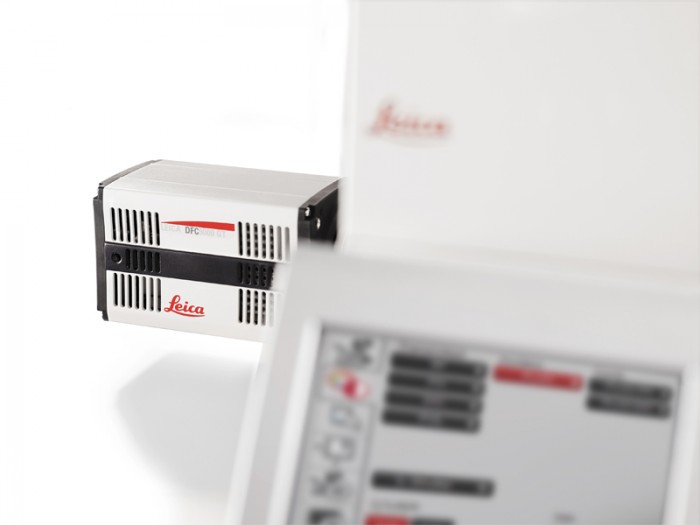Leica explains the reasons behind sCMOS cameras’ popularity

Leica DFC9000 cCMOS camera
Photo by Leica Microsystems GmbH
sCMOS cameras are more sensitive and are capable of much higher acquisition speed than cameras with other sensor types. Even though CCD cameras are widely used in live cell imaging and time-lapse recordings, researchers are often concerned that their camera does not detect faint signals.
In this interview, Dr. Karin Schwab, Product Manager at Leica Microsystems, talks about the characteristics of sCMOS cameras and how researchers benefit from the latest camera sensor technology.
Interviewer: Ms Schwab, microscope cameras with sCMOS sensors have become increasingly popular in life science research recently. Why is that so?
Karin Schwab: sCMOS cameras have two main advantages over cameras with other sensor types: They are more sensitive and are capable of much higher acquisition speed than most other cameras.
CCD cameras, for example, do a fantastic job in everyday live cell imaging such as standard time-lapse recordings. Yet, researchers are often concerned that their camera does not detect faint signals and that they miss something with the frame rates that the CCD camera achieves.
sCMOS cameras offer the sensitivity and the speed people need to capture more details. sCMOS cameras have been around a while. Why did Leica Microsystems launch the first Leica sCMOS camera now?
The market is currently transitioning from the second to the third generation of sCMOS sensors, with a tremendous improvement in this step: The third-generation sensors have amazing technical capabilities to allow imaging of samples under near-native conditions, because they are so sensitive. The core of the Leica DFC9000 is a third-generation sensor. Its quantum efficiency amounts to up to 82%, depending on wavelength, that is an improvement of approximately 14% in the maximum. That means up to 82% of the photons that strike the sensor for a given wavelength will be converted into electrons, an amazing rate. To me, now is the perfect time to launch the first Leica sCMOS camera.
Interviewer: What does such a high sensitivity mean to users of the camera?
Karin Schwab: It means that researchers can literally get closer to reality, closer to what really happens in the cells. One of the dilemmas of fluorescence live cell imaging is that researchers need to alter the cells by expressing fluorescent proteins.
There is always the risk that the cell displays a phenomenon that it wouldn’t usually or wouldn’t do to the extent that the microscope image suggests. This could be massively overexpressed proteins or degradation processes of those proteins, for example. Another factor is stress: The light cells are exposed to can stress them, so that they may suffer, and might eventually be damaged.
With a highly sensitive camera that captures large amounts of light combined with a large dynamic range and short exposure times, researchers can protect their cells from phototoxicity and also circumvent the need to examine cells with unhealthy overexpression in order to detect a signal at all. Overexpression means that too many proteins which are GFP-tagged, for example, are built within a cell erratically. It can have undesired effects, such as misleading results or conclusions in live cell research.
Interviewer: On your website you highlight that the Leica DFC9000 is capable of offering a field of view of 19 mm over the complete imaging system. Can you explain this?
Karin Schwab: The sensor diagonal of the Leica DFC9000 measures 19 mm. Combined with a microscope system with a 19 mm camera port this leads to a 19 mm field of view over the entire system so that researchers can actually see more in one go and have to acquire less images for tile scans or mosaics.
Most of Leica Microsystems’ inverted microscopes such as the Leica DMi8 and upright microscopes such as the Leica DM6 B have a 19 mm camera port with full optical correction. Especially if people are interested in getting a microscope system with camera from one vendor only, that is a very interesting option.
Interviewer: What will be next on the camera market? Where are current developments heading?
Karin Schwab: Camera sensors are developing fast, especially because cameras in mobile phones are a volume market that drives these developments. Microscope cameras are a niche market for sensor producers, but we benefit from the volume markets.
In the nearer future, I expect that CCD microscope cameras will remain successful over the next five to seven years , since they power reliable workhorse cameras in many labs. CMOS and sCMOS sensors will continue to evolve, especially in terms of noise reduction and further improvements in sensitivity. The latter is something I very much look forward to, because reducing exposure time still further is always desirable if I want to keep my cells happy.
For more information, please visit http://www.leica-microsystems.com.
News Categories
- » NEWS HOME
- » Automation & Robotics
- » Industry 4.0
- » Material Handling
- » Sensors
- » Quality & Testing
- » Machine Vision
- » Laser & Optics
- » Metalworking
- » Motion Control & Drives
- » Hydraulics & Pneumatics
- » Process Industry
- » Renewable Energy
- » Agriculture
- » Home & Office Furniture
- » Environmental Tech

